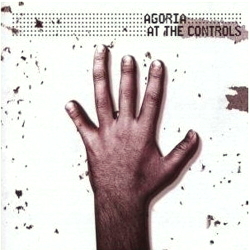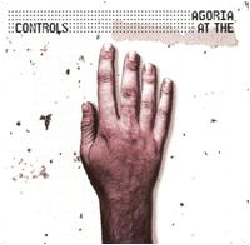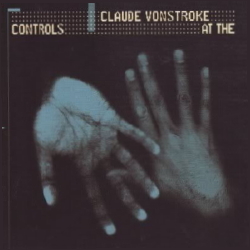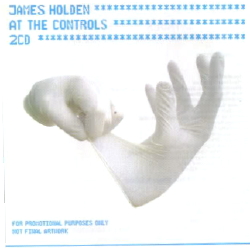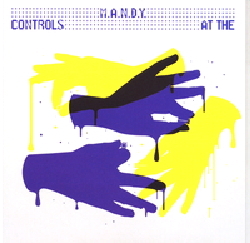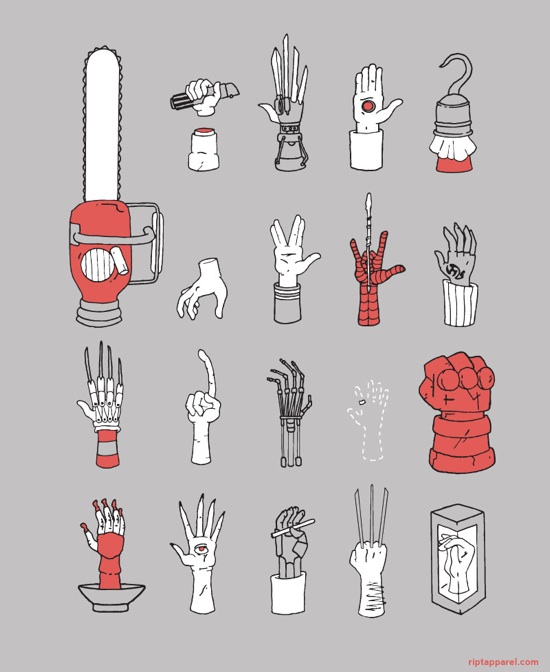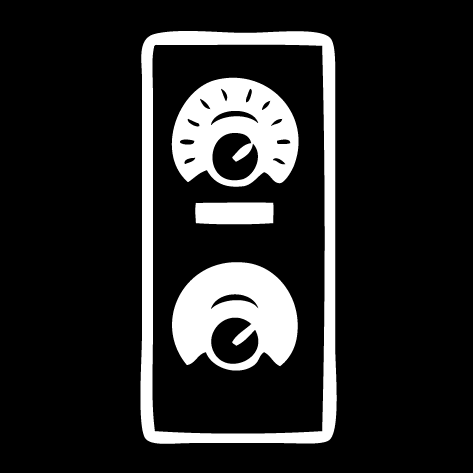Science Channel special
On 01, Mar 2010 | 2 Comments | In outreach | By Dave
High Fidelity Haptics, a demonstration I created that was shown at Fortune Magazine’s Brainstorm Tech conference, was also featured on the Science Channel. In this clip, High-Fidelity Haptics appears at 3’58.
Visualizing everything (part one)
On 25, Feb 2010 | No Comments | In space, visualization | By Dave
Not “everything” as in one-at-a-time, but as in everything at once. Macro. Meta. Big.
This first picture is a visualization of the entire history of the universe, recently produced by the WMAP space probe. WMAP’s mission is to listen to the faint reverberation that is still bouncing around since the Big Bang. Analysis of the WMAP data gives us a information not only about the size of the universe, but also its size over time. Here’s what it found.
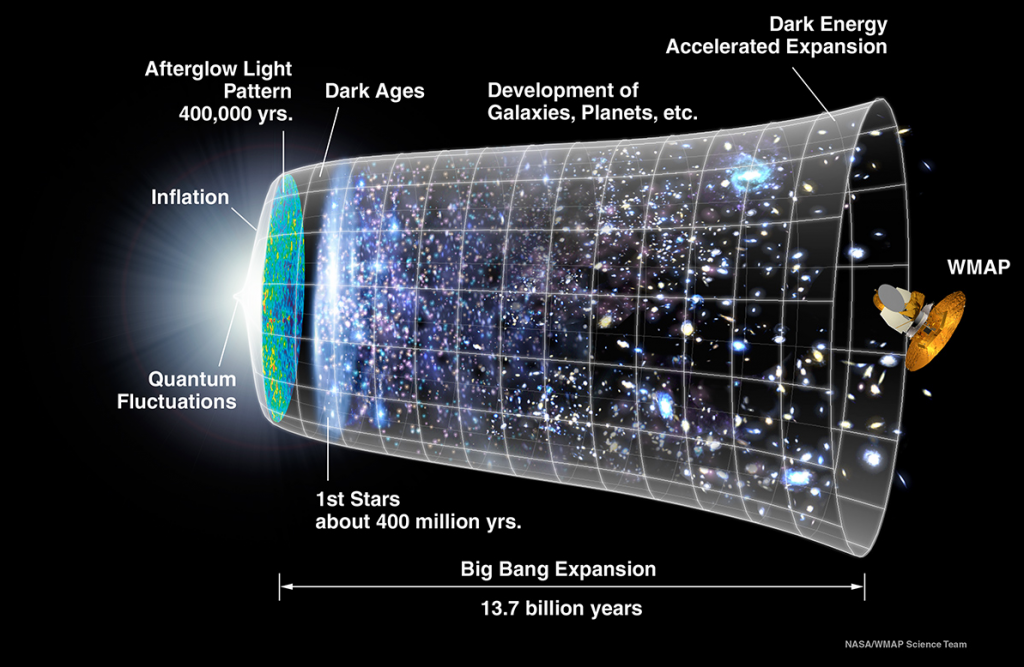
Time moves along the horizontal axis, and the size of the universe surrounds the vertical axis. It’s interesting to note that to express the size of the universe, you only need a single up-slanting line (the top edge of the cone), but in this image the line is wrapped around the horizontal axis to generate the cone structure you see. It associates the linear measurement of “size” with our idea of three-dimensional “space”. I think this visualization device works well to make the calculated size of the universe seem more tangible and real.
Now we have some idea of what the universe looks like over time. But if you disregard time and ask, what does the very largest superstructure of the visible universe look like?
Our best science says it looks like a giant morsel of luminescent bread.

It also looks strangely like a neural network, as my friend Aram pointed out. The spindles you see are billions of galaxies clumped and stretched together, called “filaments.” The dark spots are empty spaces containing nothing, called “voids,” and they have diameters of many bajillions of bajillions of whatever unit of distance you like. (Why the cube? I searched for a while and couldn’t find an explanation.)
Here’s a similar image, with map labels.

If you zoom in far enough to see (incomprehensibly giant) galaxies as single pixels, this is what you get.

How did mere humans come up with these images? They took Wittgenstein’s timeless advice: “Don’t think, look!”
Now we can visualize—we can appreciate—the magnitude of the two familiar dimensions of experience, space and time. The result is profound awe; there is really no other reaction one can have to the above images. On the other hand, these images don’t speak to the phenomenology of experience. They don’t depict the thoughts and processes that comprise our mental lives. For that we are going to need visual philosophy, which I’ll post about soon.
A Live One
On 21, Feb 2010 | One Comment | In music | By Dave
I’ve posted a new mix to my Music page. Download it there, or below.
A Live One
House | 45:17 | February 2010
Audio clip: Adobe Flash Player (version 9 or above) is required to play this audio clip. Download the latest version here. You also need to have JavaScript enabled in your browser.
Download (mp3, 95.7 MB)
1. Rico Tubbs — Hip Rave Anthem
2. Sawgood — Ctl Ur Brain (Calvertron’s Jedi Mind Trick Mix)
3. The Body Snatchers — Call Me feat. Sporty-O & Yolanda (Lee Mortimer’s Troll Under The Bridge Mix)
4. Les Petits Pilous — Wake Up
5. Wolfgang Gartner — Fire Power
6. Santiago & Bushido, Colette — Make Me Feel
7. Carbon Community, Burufunk — Community Funk (Deadmau5 Remix)
8. Neelix — Disco Decay (Felguk Mix)
9. Gooseflesh — Blow Up
10. PNAU — Embrace feat. Ladyhawke (Fred Falke & Miami Horror Remix)
Hand amputees have distorted vision
On 26, Jan 2010 | No Comments | In perception | By Dave
The space immediately surrounding the hands, where objects are grasped, touched, and manipulated, is called “action space” by psychologists. It is distinct from the wider spatial field because there is evidence that visual perception of an object is affected by the object’s proximity to the hands—i.e., its ability to be touched.
A new study has shown that hand amputees have distorted visual perception in the action space:
The space within reach of our hands—where actions such as grasping and touching occur—is known as the “action space.” Research has shown that visual information in this area is organized in hand-centered coordinates—in other words, the representation of objects in the human brain depends on their physical location with respect to the hand. According to new research in Psychological Science amputation of the hand results in distorted visuospatial perception (i.e., figuring out where in space objects are located) of the action space….
Volunteers were instructed to look at a central cross on a screen as two white squares were briefly shown to the left and right side of the cross. The volunteers had to indicate which of the squares was further away from the cross. The results reveal that hand amputations affect visuospatial perception. When the right square was slightly further away from the center, participants with right-hand amputations tended to perceive it as being at the same distance from the center as the left square; this suggests that these volunteers underestimated the distance of the right square relative to the left. Conversely, when the left square was further away, participants with left-hand amputations perceived both squares as being equally far away from the center—these participants underestimated the left side of near space. Interestingly, when the volunteers were seated farther away from the screen, they were more accurate in judging the distances, indicating that hand amputations may only affect perception of the space close to the body.
The findings suggest that losing a hand may shrink the action space on the amputated side, leading to permanent distortions in spatial perception. According to the researchers, “This shows that the possibility for action in near space shapes our perception—the space near our hands is really special, and our ability to move in that space affects how we perceive it.“
Among journalists, technology breeds fear of obsolescence, corporations
On 24, Jan 2010 | One Comment | In sociology, tactility | By Dave
Another NYT article about technology anxiety, this one by Brad Stone. Some excerpts:
I’ve begun to think that my daughter’s generation will also be utterly unlike those that preceded it.
Well, it’s better to begin to think than to never start. There’s plenty of room for more people to contemplate and write about the future of technology. We are a friendly bunch! Let me be the first to welcome you, Mr. Stone.
But the newest batch of Internet users and cellphone owners will find these geo-intelligent tools to be entirely second nature, and may even come to expect all software and hardware to operate in this way. Here is where corporations can start licking their chops. My daughter and her peers will never be “off the grid.” And they may come to expect that stores will emanate discounts as they walk by them, and that friends can be tracked down anywhere.
I see, so even though technology will lift people out of poverty and make life longer and more enriching, technology is really just a vehicle for capitalist oppression. And like mad, salivating dogs, corporations will lick their chops. Right.
But the children, teenagers and young adults who are passing through this cauldron of technological change will also have a lot in common. They’ll think nothing of sharing the minutiae of their lives online, staying connected to their friends at all times, buying virtual goods, and owning one über-device that does it all. They will believe the Kindle is the same as a book. And they will all think their parents are hopelessly out of touch.
Of all the mind blowing changes that technology will bring to our society, the real thought-provoker is that those crazy young’uns will think a Kindle is the same as a book!
Mr. Stone: elevate your perspective. If you need help, read my blog, and read what I link to. Anticipate the future. Integrate it. Do develop a grounded, holistic understanding of where we’re going as a technological society. Don’t develop sociological theories based on your marvel at incremental steps like the Kindle. It won’t help you see the big picture.
Wordplay
On 23, Jan 2010 | No Comments | In art, photography | By Dave
It’s what we do.

Kenneth Josephson
Chicago
1988
Living With Robots
On 22, Jan 2010 | No Comments | In robotics | By Dave
I’m very excited for this film. Asimo looks fantastic in it!
I think we’re on the verge of seeing a lot more examination of the relationship between humans and robots.
Midnight snack
On 16, Jan 2010 | No Comments | In art | By Dave

Francis Bacon
One of Three Studies for Figures at the Base of a Crucifixion
c. 1944
Perceptual chauvinism
On 11, Jan 2010 | No Comments | In medical, music, perception | By Dave
I read two articles in a row today that use unnecessary quotation marks, which expose that strange discomfort with writing about touch I have written about before. As humans we hold our feelings dear, so we don’t like to say that any other beings can feel. Especially plants, for chrissake:
Plants are incredibly temperature sensitive and can perceive changes of as little as one degree Celsius. Now, a report shows how they not only “feel” the temperature rise, but also coordinate an appropriate response—activating hundreds of genes and deactivating others; it turns out it’s all about the way that their DNA is packaged.
The author can’t simply say that plants can feel, so instead he writes “feel,” indicating a figurative sense of the word. Why? Because the word ‘feel’ implies some amount of consciousness. (In fact I have argued that ‘feeling’ signifies a baseline for the existence of a subject.) Only the animal kingdom gets feeling privileges.
And then, in another article posted on Science Daily, we have a similar example, but this one is even more baffling. The context is that research has shown that playing Mozart to premature infants can have measurable positive effects on development:
A new study… has found that pre-term infants exposed to thirty minutes of Mozart’s music in one session, once per day expend less energy—and therefore need fewer calories to grow rapidly—than when they are not “listening” to the music…
In the study, Dr. Mandel and Dr. Lubetzky and their team measured the physiological effects of music by Mozart played to pre-term newborns for 30 minutes. After the music was played, the researchers measured infants’ energy expenditure again, and compared it to the amount of energy expended when the baby was at rest. After “hearing” the music, the infant expended less energy, a process that can lead to faster weight gain.
Not allowing plants to feel is one thing. And I can even understand the discomfort with writing that newborns are listening to music, because that may imply they are attending to it, which is questionable. But why can’t human babies be said to hear music? This is the strangest case of perceptual chauvinism I have yet come across.
Meet physical addiction with physical destruction
On 09, Jan 2010 | No Comments | In medical | By Dave
Other notable findings include the following: smokers who crushed virtual cigarettes tended to stay in the treatment program longer (average time to drop-out > 8 weeks) than the ball-grasping group (< 6 weeks). At the 6-month follow-up, 39% of the cigarette crushers reported not smoking during the previous week, compared to 20% of the ball graspers.
Sudden breakthrough
On 08, Jan 2010 | No Comments | In art, photography | By Dave
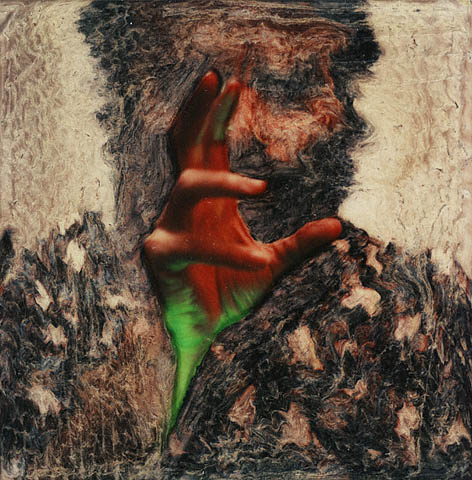
Lucas Samaras
Photo-Transformation
November 22, 1973
Thought-to-text
On 06, Jan 2010 | No Comments | In interfaces, transhumanism | By Dave
This is a welcome incremental step towards brain-controlled text input. The other interesting about this experiment is that it was done on people who already had electrodes implanted in their brain to monitor and study their epilepsy. The scientists thought that the electrodes’ output might be able to be controlled with thought, and it turns out it can.
This is very different than the typical brain-computer interface, which uses electroencephalography (EEG). Basically, an EEG is a helmet that oozes tricolor pasta:
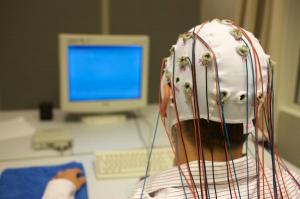
But an eletrocorticograph (ECoG, pronounced “eecog”), like the one used for this experiment, sits on the brain itself, like this:

Fingerprint ridge width is coupled to Pacinian resonance
On 05, Jan 2010 | No Comments | In perception, physiology, robotics | By Dave
French scientist Georges Debregeas has published a finding that the width of the ridges of our fingerprints just happens to be optimized for maximally vibrating our nerve endings:
The latest evidence suggests that fingerprints process vibrations in the skin to make them easier for nerves to pick up. They may seem little more than digital decoration, but biomechanics have long known that fingerprints have at least one use: they increase friction, thereby improving grip…
In fact the role that fingerprints play in touch is far more important and subtle than anyone imagined.
…Biologists have known for some time that Pacinian corpuscles are most sensitive to vibrations at 250Hz. So how do fingers generate this kind vibration? Biologists have always assumed that humans can control the frequency of vibrations in the skin by changing the speed at which a finger moves across a surface. But there’s little evidence that people actually do this and the Paris team’s discovery should make this view obsolete.
…They say that fingerprints resonate at certain frequencies and so tend to filter mechanical vibrations. It turns out that their resonant frequency is around 250 Hz. What an astonishing coincidence!
That means that fingerprints act like signal processors, conditioning the mechanical vibrations so that the Pacinian corpuscles can best interpret them…
The article also notes that in robotics this is called morphological computation; that is, computation through interactions of physical form.
“We’re stimulating areas of the retina that are downstream from the rod and cone cells… [to] directly send impulses to the brain.”
On 03, Jan 2010 | No Comments | In transhumanism | By Dave
Watch this beautiful video by National Geographic about Jo Ann Lewis, the 17th recipient of a bionic eye implant. The video shows the surgery itself, so it may be unsettling to some. Because I know the surgeon is making a blind woman see, the gore a non-issue for me. From a technical standpoint, it’s a rare and fascinating close-up of a procedure to wire up a sensor to a human nerve.
The name of the surgeon is Rand Spencer, M.D., and we need many more like him.
Skin receptors may contribute to emotion
On 02, Jan 2010 | No Comments | In language, neuroscience, perception, physiology | By Dave
Interoception, the perception of internal feelings, is a funny thing. From our point of view as feeling beings, it seems entirely distinct from exteroceptive channels (sight, hearing, and so on). Interoception is also thought to be how we feel emotions, in addition to bodily functions. When you feel either hungry or lovesick, you are perceiving the state of your internal body, organs, and metabolism. A few years ago it was discovered that there are neural pathways for interoception distinct from ones used to perceive the outside world.
Interesting new research suggests that mechanical skin disturbances caused by pulsating blood vessels may significantly contribute to your perception of your own heartbeat. This is important because it means that skin may play a larger role in emotion than has been previously thought.
The researchers found that, in addition to a pathway involving the insular cortex of the brain — the target of most recent research on interoception — an additional pathway contributing to feeling your own heartbeat exists. The second pathway goes from fibers in the skin to most likely the somatosensory cortex, a part of the brain involved in mapping the outside of the body and the sense of posture.
This sounds surprising at first, but it makes perfect sense. There have been other instances where the functionality of perceptual systems overlap. For example, it’s been found that skin receptors contribute to kinesthesia: as the joints bend, sensations of skin stretch are used to perceive of joint angles. This was also somewhat surprising at the time, because it was thought that perception of one’s joint angles arose out of the receptors in the joints themselves, exclusively. The same phenomenon, of skin movement being incidentally involved in some other primary action, is at work here. We might be able to say that any time the skin is moved perceptibly, cutaneous signals are bound up with the percept itself.
In fact, I think this may be a good object lesson in how words about feelings can be very confusing. A few years ago, before the recent considerable progress in mapping the neural signature of interoception, the word ‘interoception’ was used to describe a class of perceptions—ones whose object was the perceiver. Interoception meant the perception of bodily processes: heartbeat, metabolic functioning, and so on. When scientists discovered a neural pathway that serves only this purpose, the word suddenly began to refer not to the perceptual modality, but exclusively to that neural pathway. Now that multiple pathways have been identified, the word will go back to its original meaning: a class of percepts, rather than a particular neural conduit.
2009 in review: A solar system awash in hope
On 31, Dec 2009 | No Comments | In space | By Dave
2009 is probably not very high on anyone’s list of Totally Awesome Years. Our society has been set on a track toward painful socioeconomic changes, and there has been a worrisome deepening of geopolitical rifts. But as the halfwits in the media class clucked and squabbled amongst themselves, they missed the biggest story of all: in 2009 the long-term prospects for the human experiment became considerably brighter. In fact, we have just lived through a banner year for the human species, because this was the year that we learned that leaving our mother planet to live elsewhere is a tangible possibility.
In recent months, several lines of scientific investigation converged and the result seems to be that humankind has gained the ability to prospect for water on other worlds. Most significantly, the LCROSS lunar impactor shot straight into a crater at 1.5 miles per second. It was literally a bombshell, but its impact on history will be no less great—the colossal smash sent giant chunks of ice from our moon flying into space.
A few weeks before, an analysis of the light bouncing off the moon had indicated that lunar dirt contains trace amounts of water all across its surface. Extracting this water would be more difficult than mining the plentiful ice in the craters, but it could be done.
By the beginning of this year, the Phoenix Mars Lander had already detected—in fact, stepped on—ice near the Martian south pole. But now a camera orbiting Mars has snapped pictures of 99% pure ice near the equator, which has an environment far more hospitable to humans and our technology than the poles do.
If this year’s discovery of additional evidence that Mars was once covered in oceans had been discovered a short while ago, it would again have been interpreted by the green movement as an ominous warning of what was in store for Earth. Instead, in the context of this year’s water discoveries, Mars has become a friendlier place. We now know that we could survive there using today’s technology, if it were important enough to do so.
In the media, and our culture generally, a dearth of imagination has prevented the long-term implications of all this from being noticed, and it’s terribly disheartening to see. The water discoveries should have been celebrated, if not with fanfare, at least with rapturous conversation around every dinner table in the world. “Have you heard? If a global catastrophe makes Earth uninhabitable, there’s a place we can go!” But unless you follow space news, you probably weren’t even aware that these discoveries had fundamentally changed the calculus of our society’s future and even the destiny of our species.
Lunar ice means that large scale colonization of the moon is now possible decades earlier than it would have been had the moon been barren. That saved time could make all the difference in a pinch. Imagine that a few decades after a robust lunar colony is established, an asteroid, epidemic, or nuclear war ravages our home planet. We will have lunar water (and the fact that we knew about it) to thank for the preservation of human culture and knowledge.
Importantly, this increased access to the moon has put it within reach of privately funded excursions. It is now likely that individual and corporate homesteaders could establish and defend lunar property rights before governments mobilize to prevent them, promoting the cause of liberty and spreading Karl Popper’s Open Society into the cosmos.
The transition from an Earth-bound civilization to a space-faring one will start with the moon, making Mars colonization an incremental step rather than a giant leap. Relatively soon after a lunar colony is established, the skills and technologies developed to extract lunar water for drinking, breathing, and fuel-making will be further developed to do the same tasks on Mars. People will become experienced with the four-day journey between Earth and the moon, which will greatly simplify the logistics of moving personnel and cargo to the Red Planet.
Another important discovery was made in 2009 that made Mars more accessible: it became half as far away. Ion engines have already proved themselves on deep space probe missions, but this year a redesigned engine called VASIMIR was announced that greatly extends the thrust and efficiency of ion drives. With these new engines, set to be tested in 2010 aboard the International Space Station, Mars could conceivably be reached in only 39 days—almost exactly half the time it took Columbus to reach the New World.
Stephen Hawking is right when he says that if we don’t colonize other worlds in the near future our species will become extinct sooner rather than later. This year’s discoveries of water on the moon and Mars is a profound gift—one that might extend the longevity of the human species by an order of magnitude. Despite all the headaches and misadventures this year, 2009 may not have been a washout after all.
“And reaching up my hand to try, I screamed to feel it touch the sky.”
On 22, Dec 2009 | No Comments | In art, language, tactility | By Dave
Check out this beautiful kinetic typography piece by Heebok Lee:
It’s based on an excerpt of the poem “Renascence” by Edna St. Vincent Millay.
- renascence
- noun
- 1. the revival of something that has been dormant.
- 2. another term for ‘renaissance.’
- (Oxford English Dictionary)
Millay, who wrote the poem when she was only 20 years old, originally called it “Renaissance.” It’s interesting that the two words are so close in meaning and are pronounced almost the same way, but they’re not considered alternate spellings of the same word.
 |
Click below to read the poem in its entirety. I highly recommend reading the whole thing.
Read more…
What can gardens teach us about digitality?
On 20, Dec 2009 | One Comment | In sociology, tactility | By Dave
The Washington Post has an intriguing piece about a book dealing with gardens (of all things) and digitality. The author, Robert Harrison, argues that gardens immerse us in place and time, and that digital devices do not. The article jumps all over the place, talking about mobile communication, cultural anthropology, and evolution, but it makes several important points.
To start, attending to digital devices is said to preclude being present:
“You know you have crossed the river into Cyberland when the guy coming your way has his head buried in the hand-held screen. He will knock into you unless you get out of his way, and don’t expect an apology. It’s as if you aren’t there. Maybe you’re not.”
I’m very interested in language like this, because it’s a metaphor in the process of becoming a literalism. Today, saying that you’re not there because you’re looking at a device is metaphorical, but I think that the meaning of ‘being there’ is going to change to mean where you are engaged, no matter where its geographical location is in relation to you. “I’ll be right there!” he said as he plugged his brain into the internet. Moments later he was standing in the garden…
The article quotes a study that claims that the average adult spends 8.5 hours a day visually engaged with a screen. 24-hour days, split up by 8.5 hours of screen and 8 hours of sleep—the Screen Age really does deserve its own delineation. It’s a significant and unique period in human history.
And just like sleep, perhaps disturbingly so, people looking at screens can resemble dead people (or, more accurately, un-dead people):
…We have become digital zombies.
But I think the resemblance is entirely superficial. Sure, if you only go by appearances, an army of screen-starers is a frightening sight to imagine. But scratch the surface and you realize that screen-staring is a far cry from zombism. The social spaces we are constructing while we stare, the vast data stores we are integrating—these activities remind me of life. Teeming life. Our bodies may be sedentary, our eyes fixed on a single glowing rectangle, but what is going on is indisputably amazing. On the microscopic level there are billions of electrical fluctuations per moment, both in our brains and our machines, and they are actively correlating and adapting to each other. Patterns of thought are encoded in a vast network of micro-actions and reactions that span the planet. And what is it like for you when you stare at a computer or phone screen? You juggle complex, abstract symbolic information at speeds never before achieved by human brains, and you’re also inputting—emitting—hundreds of symbols with the precise motor skills of your fingers. You are recognizing pictures and signs, searching for things, finding them, figuring stuff out, adjusting your self image, and nurturing your dreams. There is no loss of dignity or life in this. But I admit that we all look like zombies while we do it, and I suppose that is pretty weird.
The article goes on to quote author Katherine Hayles, who says she thinks humans are in a state of symbiosis with their computers:
“If every computer were to crash tomorrow, it would be catastrophic,” she says. “Millions or billions of people would die. That’s the condition of being a symbiont.”
Let that sink in. At any moment a catastrophic event could fry our entire digital infrastructure in one fell swoop. Our civilization teeters on a house of cards as high as Mount Everest! To me this is the only reason the Screen Age should be frightening, but it’s very frightening indeed.
Turning now to sensation, Hayles mentions that touch and smell are suppressed by bipedalism:
“You could say when humans started to walk upright, we lost touch with the natural world. We lost an olfactory sense of the world, but obviously bipedalism paid big dividends.”
Note that bipedalism is associated with a loss of tactility, but it has also been correlated with enabling more complex manual dexterity. Maybe there is a general principle here that ambient tactile awareness is inversely correlated to prehension.
After a brief ensuing discussion of dualism and the advent of location-based services, we’re back to the gardens:
The difficulty, Harrison argues, is that we are losing something profoundly human, the capacity to connect deeply to our environments… “For the gardens to become fully visible in space, they require a temporal horizon that the age makes less and less room for.”
I like the point about a gardens’ time horizon. But it’s used to complain about the discomfort of our rushed lifestyle, which I would argue is separable from communication technology. The heads-buried-in-screens thing doesn’t really affect whether we have time for gardens.
An interesting footnote offered by Harrison is that the Czech playwright Karel Capek, who invented the word ‘robot,’ was a gardener.
Finally, this is the photo that accompanies the article:
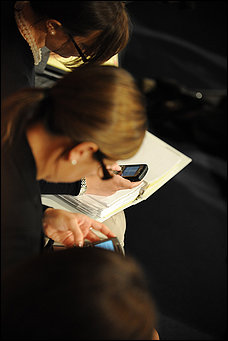
…captioned, “Fingers on the political pulse.” The article is about looking and being present, but the picture is about hands, heatbeat, and hapticity.
(via Althouse)
Bootboxing
On 19, Dec 2009 | No Comments | In music | By Dave
noun. Making music by applying human bodies to cars. E.g.,
(via Autoblog)
Taking pictures of vibrating molecules
On 07, Dec 2009 | No Comments | In unclassifiable | By Dave
Scientists at UC Berkeley have used an advanced laser spectroscopy technique to image the vibration of a molecule as it absorbs a photon:
Femtosecond stimulated Raman spectroscopy on GFP involves hitting the protein molecule with an approximately 80 femtosecond pulse of ultraviolet light, which excites many vibrational modes in the molecule, and then a one-two punch of picosecond red and femtosecond white light to stimulate Raman emission. The spectrum of emitted signals tells researchers the vibrational modes of various parts of the molecule. If the molecule is in the middle of a reaction, the emitted light at different time delays tells the researcher the various steps the molecule goes through during the reaction. “Now, we can get very, very high resolution structure down to 10-25 femtoseconds,” Mathies said.
That’s femtoseconds, with an ‘f’. Wild!
At The Controls
On 06, Dec 2009 | No Comments | In art, music | By Dave
I recently discovered an excellent series of electronic music compilations called At The Controls. The album covers are amazing and relevant too—they are all variations on modified modifiers.
